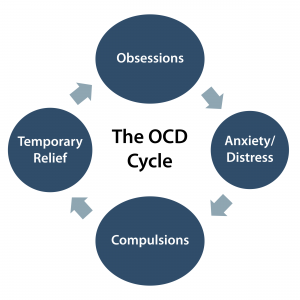
Exposure Response Prevention Therapy for OCD: What is it and why do we use it?
Exposure and Response Prevention or “ERP,” is the frontline treatment for all subtypes of Obsessive Compulsive Disorder (OCD) and for a good reason. It’s an evidence-based treatment, which basically means there has been tons of research and testing done that yields high results for symptom reduction and long-term management of OCD. In order to understand the benefits of ERP, it’s important to understand the OCD cycle and how symptoms of the condition are maintained.
First it’s important to note that OCD is a highly heritable condition, meaning that genetics plays a large role in the onset of OCD symptoms. Those that are wired for OCD struggle with unwanted and sometimes disturbing thoughts, feelings, images, and/or sensations that cause significant and recurrent distress, and are difficult to pivot away from or control. Some obsessions are focused on possible bad things happening in the future or are just unpleasant and uncomfortable to be experiencing or thinking about. There can be internal or external triggers that elicit these obsessions, or there can be no trigger at all.
The obsession triggers a state of intolerable anxiety, fear, and/or discomfort which create an urge to engage in some form of behavior (compulsion) that alleviates the intrusive thought, feeling, or sensation, which results in a short-term decrease in anxiety and discomfort. However, we refer to this process as the “OCD cycle” because the relief is temporary and repetitive. Every time the person experiences an intrusive thought, feelings, or sensation then they repeat what “worked” before and engage in repetitive and compulsive behaviors in order to get immediate but temporary relief.
Below is an illustration of the OCD cycle:

While there are various OCD subtypes and varying obsessions and compulsions that individuals may experience, the cycle remains the same. Unfortunately, we know that engaging in compulsions actually strengthens the anxiety and discomfort response because we don’t allow the opportunity to test out whether the bad thing will actually happen and/or whether we can tolerate the obsessions and state of discomfort/anxiety without trying to get rid of it via compulsions. This is where ERP comes in.
Ok so back to the point of this blog. What is ERP and how does it work? Here’s a nice definition taken from the International OCD Foundation website:
“The exposure in ERP refers to exposing yourself to the thoughts, images, objects, and situations that make you anxious and/or start your obsessions. While the response prevention part of ERP, refers to making a choice not to do a compulsive behavior once the anxiety or obsessions have been ‘triggered’ (IOCDF, 2021).”
What ERP aims to do is help individuals stop engaging in compulsions in order to cope with anxiety inducing thoughts and experiences. Continuing the OCD cycle decreases tolerance to uncertainty and discomfort, which can lead to individuals feeling very vulnerable in the world and being controlled by OCD. Choosing not to engage in compulsions and seek temporary relief as a default is the Response Prevention part of treatment, and this occurs while engaging in an Exposure. As mentioned above, an exposure is an act that revolves around intentionally exposing yourself to an unwanted thought, sensation, feeling, or image in order to increase anxiety or start the obsession. Yes, you read that correctly. And don’t worry, we as therapists wouldn’t ask anyone to do anything they aren’t ready to do, and we would never ask our clients to do something we wouldn’t do as therapists right along with them. To put things simply, we exposure therapists work together to help people face their fears in a safe, supportive, and collaborative space.
While this might sound scary, there are a few steps we take before jumping into exposures. The initial sessions are used to learn more about what OCD actually is and how OCD shows up in daily life. Clients may be asked to track their experiences, triggers, feelings, and compulsions as part of the process. Sometimes emotion regulation and grounding skills are practiced in the early stages of treatment, to help teach the nervous system how to shift out of fight/flight mode and into regulated states when activated. Once a client is ready to begin breaking the OCD cycle, they will work together with their therapist to develop a graduated list of exposures to engage in. This is what is known as a hierarchy or fear ladder, and there will be exposures ranging from kind of scary to “heck no I won’t do this” with a lot in between. Some exposure might be “in vivo”, or related to confronting actual triggers in real life, and some might be “imaginal”, often used when we can’t recreate a feared outcome in real life. Remember, the point of all of this is to learn that you can tolerate uncertainty, anxiety, and discomfort without engaging in the OCD cycle.
Here at Straight Up Treatment we value meeting our clients where they are at while also encouraging them to step out of their comfort zones. We are also integrative therapists, which means we incorporate a variety of evidenced-based techniques to help support ERP intervention and do whatever it takes to help clients break-free of the OCD cycle, so they can feel more confident and live life based on what actually matters, as opposed to primarily managing and trying to control OCD.
Dr. Yumi Terajima is a licensed psychologist who specializes in working with teens and adults struggling with anxiety, OCD, perfectionism, and relationship challenges. If you, your child, or someone you know are interested in learning more about Straight Up Treatments approach and services you can email hello@straightuptreatment.com to schedule a free initial consultation.





